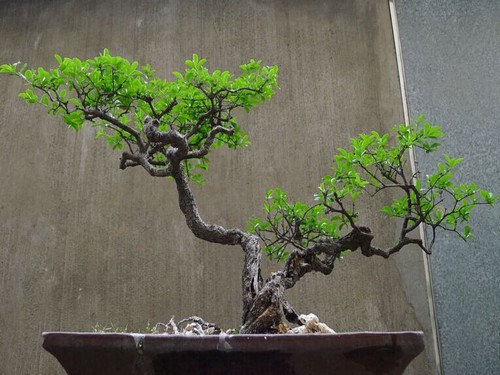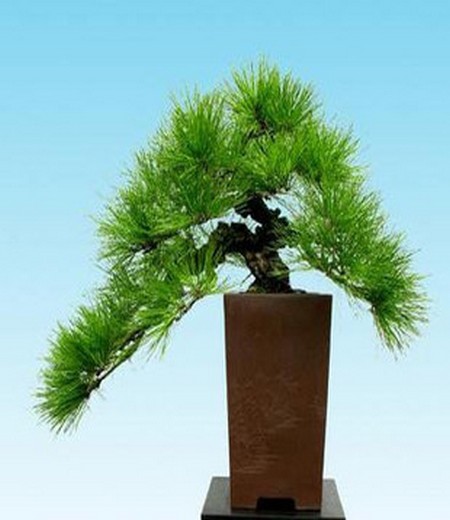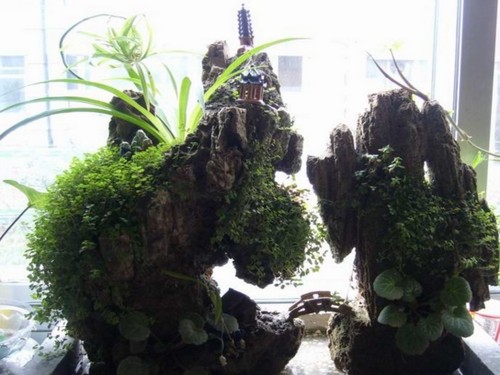A Method for Making Ligustrum lucidum Bonsai
Leaflet Ligustrum lucidum has dense branches and leaves, white flowers and purple fruits, evergreen all the year round, but the effect is the best in spring and summer. Take its old stump, the root of the ancient trunk oblique, Qiu qu colorful, branches and leaves shape, layers of overlap, more ornamental value. Next, I would like to introduce the production method of lobular privet bonsai.

[picking piles]
Ligustrum lucidum can be picked in both spring and autumn, but it is best on the eve of recovery in early spring. Piles with joints, folds or obvious changes up and down the pile head (from the root up to down from thick to thin, bamboo shoots) should be selected.
[on the basin]
Selection of basin: lobular privet commonly used purple sand basin or glazed pottery basin, basin shape depends on the tree, generally with shallow rectangular or oval basin for more.
Use soil: loose and fertile loam is better for pot planting, usually rotten leaf soil or mature pastoral soil can be used.
Planting: it is appropriate to plant in the basin from February to March in spring. if you plant in a shallow pot, you must fasten the root and the bottom of the basin with wire. The root should be filled with sandy loam to facilitate air and water permeability, and the root can be slightly exposed.
[pruning]
The germination ability of lobular privet is very strong. In order to control its growth, unwanted buds should be picked in time in spring. After sending new shoots, the first 1-2 segments should be cut off to prevent overgrowth. Usually pay attention to pruning excess branches and growing branches at any time to maintain the shape of the tree.
[pose]
Processing: lobular Ligustrum lucidum is strong and resistant to pruning. It is appropriate to use the method of coarse pruning and fine pruning, that is, the trunk and main branches can be properly clambered with brown wire or wire, and then the branchlets can be pruned carefully.
Tree shape: lobular privet has strong germination and plasticity, which is generally made into straight dry type, double dry type, oblique dry type, curved dry type and cliff type and so on. Its branches and leaves can be shaped into cloud flakes or steamed buns, or they can be trimmed into natural trees.
[turning the basin]: it should be carried out every 2-3 years, preferably before sprouting in 22-March in spring, or in autumn. Combined with turning the basin to trim the root system, remove the old 1B2 soil and replace it with fertile and loose culture soil to promote growth.
Time: 2019-05-26 Click:
- Prev

How to make Penglai bonsai
Penglai pine is a popular bonsai with tall and straight stems, emerald green color and luxuriant leaves. However, Penglai pine cultivation management is simple, and good shade resistance, suitable for small and medium-sized pot planting, is a good product for bonsai production. Then how to make Penglai bonsai? Next
- Next

Production method of Sheung Shui Stone Bonsai
Dear, don't worry about the indoor dryness caused by turning on air-conditioning and heating for a long time in winter, and adults and children can't stand it. Because you have a natural humidifier water stone bonsai. Sheung Shui stone bonsai is a landscape formed by the arrangement and combination of mountains, stones, grass and trees in the urn. Sheung Shui stone bonsai is made of landscape bonsai.
Related
- Fuxing push coffee new agricultural production and marketing class: lack of small-scale processing plants
- Jujube rice field leisure farm deep ploughing Yilan for five years to create a space for organic food and play
- Nongyu Farm-A trial of organic papaya for brave women with advanced technology
- Four points for attention in the prevention and control of diseases and insect pests of edible fungi
- How to add nutrient solution to Edible Fungi
- Is there any good way to control edible fungus mites?
- Open Inoculation Technology of Edible Fungi
- Is there any clever way to use fertilizer for edible fungus in winter?
- What agents are used to kill the pathogens of edible fungi in the mushroom shed?
- Rapid drying of Edible Fungi

